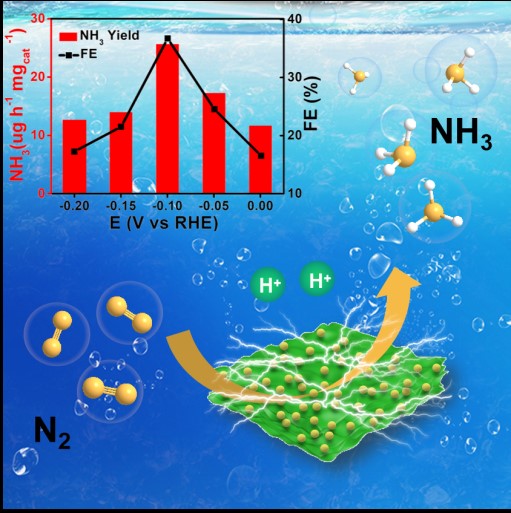A hybrid catalyst for efficient electrochemical N2 fixation formed by decorating amorphous MoS3 nanosheets with MIL-101(Fe) nanodots
Wan-Ying Xu , Cong Li , Fei-Long Li , Jiang-Yan Xue , Wei Zhang , Hongwei Gu , Brendan F. Abrahams , Jian-Ping Lang

Metal-organic frameworks possessing relatively large pores, high surface areas, and unsaturated metal sites are attractive materials for use as electrocatalysts in the reduction of N2 to NH3. In this work, a MIL-101(Fe)/MoS3 hybrid catalyst, prepared by using a precursor-transformation strategy, is shown to be an effective electrocatalyst for the N2 reduction reaction (NRR). Under solvothermal conditions, micro-sized octahedral MIL-101(Fe) precursors are converted into ultra-small nanodots, while amorphous MoS3 derived from (NH4)2MoS4 provides a surface suitable for anchoring the MIL-101(Fe) nanodots. The as-prepared composite exhibits excellent electrocatalytic activity and durability for the NRR with a Faraday efficiency of 36.71% and an NH3 yield of 25.7 µg h−1 mg−1cat at −0.1 V vs. RHE in 0.1 M HCl. The results show that the dispersion and adherence of MIL-101(Fe) nanodots on amorphous MoS3 improves the exposure of active centers and aids mass transfer, resulting in greatly enhanced catalytic activity and stability.
用 MIL-101(Fe) 纳米点装饰无定形 MoS3 纳米片形成的用于高效电化学 N2 固定的混合催化剂
具有较大孔、高表面积和不饱和金属位点的金属有机骨架是用作将N 2还原为NH 3的电催化剂的有吸引力的材料。在这项工作中,通过使用前体转化策略制备的 MIL-101(Fe)/MoS 3杂化催化剂被证明是 N 2还原反应 (NRR) 的有效电催化剂。在溶剂热条件下,微米级八面体 MIL-101(Fe) 前驱体转化为超小纳米点,而由 (NH 4 ) 2 MoS 4衍生的无定形 MoS 3提供适合锚定 MIL-101(Fe) 纳米点的表面。所制备的复合材料对 NRR 表现出优异的电催化活性和耐久性,法拉第效率为 36.71%,NH 3产率为 25.7 µg h -1 mg -1 cat在-0.1 V vs . 0.1 M HCl 中的 RHE。结果表明,MIL-101(Fe)纳米点在无定形MoS 3上的分散和粘附提高了活性中心的暴露并有助于传质,从而大大提高了催化活性和稳定性。
DOI: 10.1007/s11426-021-1206-2

